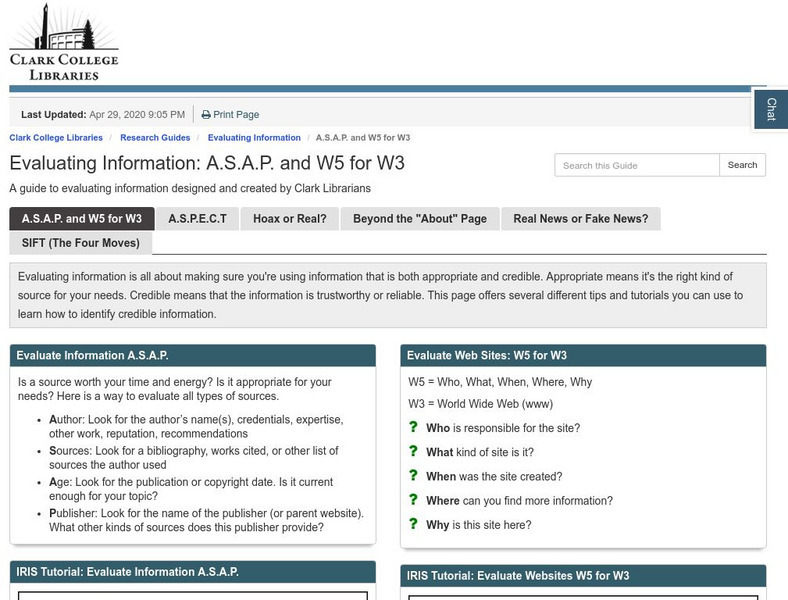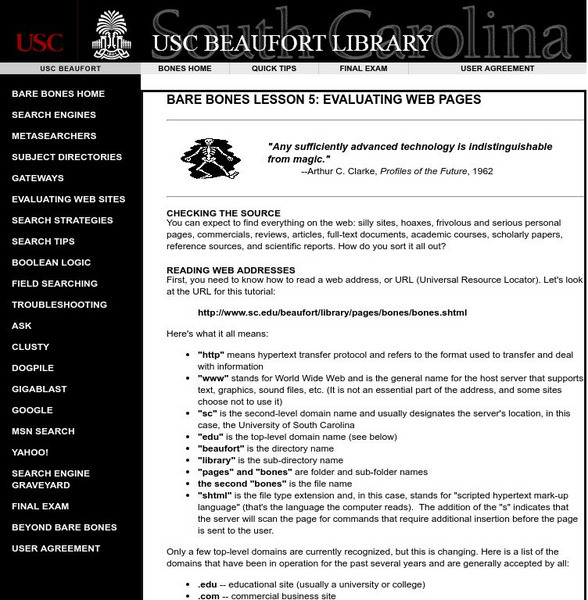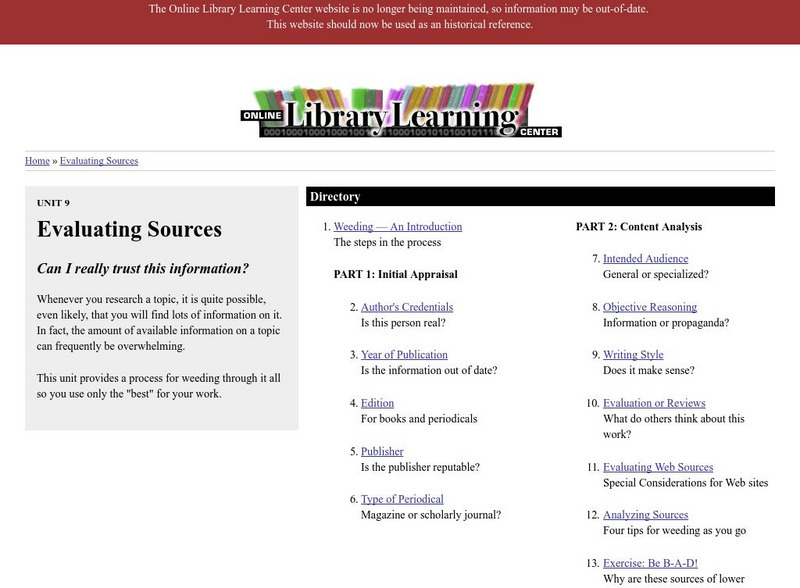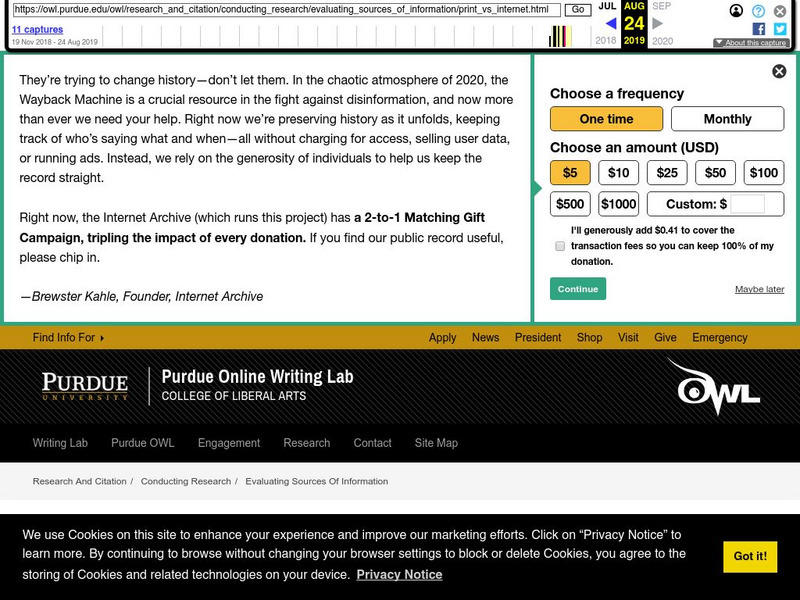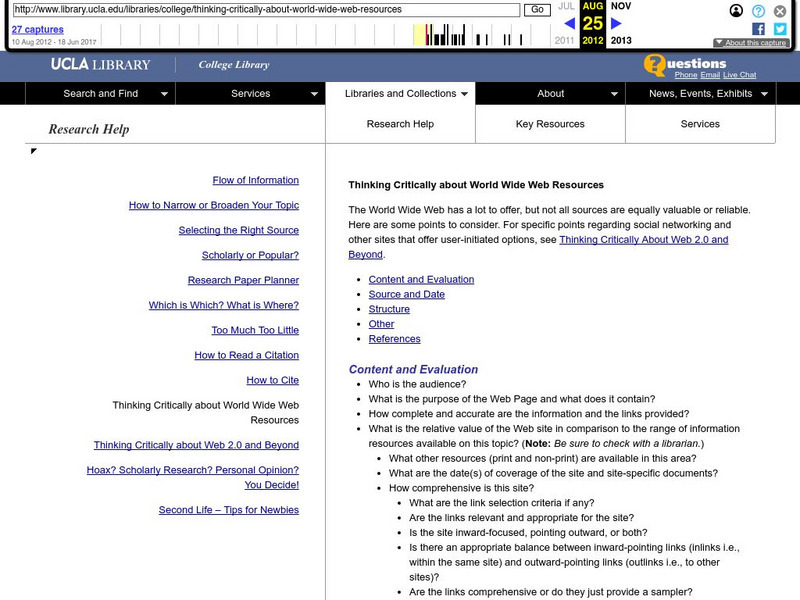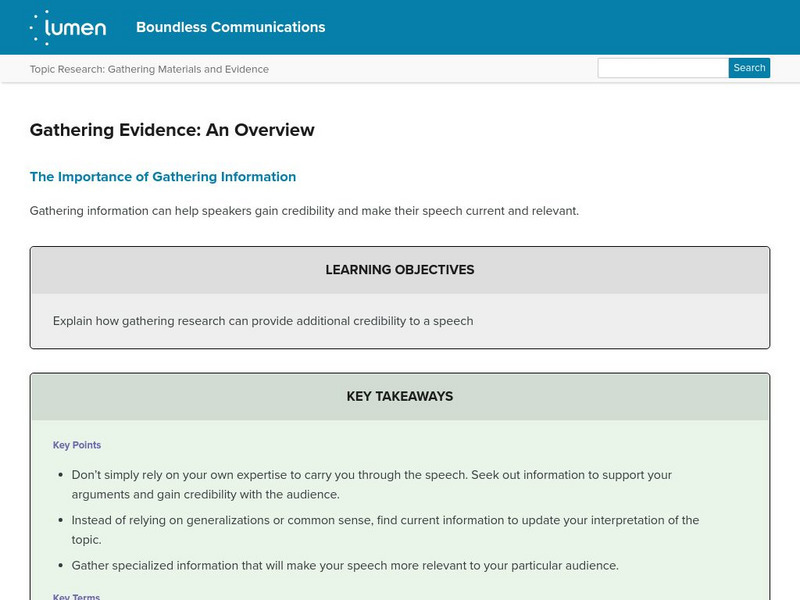PBS
Pbs Learning Media: The Impact of the Erie Canal on America
Students will learn how the creation of the Erie Canal changed the environment to be more advantageous. This transportation waterway impacted American culture, economics, politics, and more. It set America on a path of destiny, from a...
Other
Clark College Libraries: Evaluating Information: Hoax or Real?
You probably know that anyone can put anything on the web. You might even be aware that much information on the web is inaccurate. Some misinformation is unintentional - a result of sloppy or incomplete research. But other sites contain...
Other
Portland Community College: Know Your Sources: A Guide to Understanding Sources
When doing research you will come across a lot of information from different types of sources. How do you decide which source to use? From tweets to newspaper articles, this tool provides a brief description of each and breaks down 6...
Arizona State University
Arizona State U.: Research Success for High School Students: Evaluating Sources
A collection of resources for evaluating sources. Topics covered include knowing your sources, assessing whether a source is scholarly, the CRAAP Test (includes chart, worksheet, and website evaluation sheet), and how to identify fake news.
Other
Loyola Marymount University: Evaluating Sources: Using the Radar Framework
The RADAR Framework can help you remember what kinds of questions you should be asking about an information source as you evaluate it for quality and usefulness in your research. The Framework can be downloaded in PDF format. Includes...
PBS
Pbs Learning Media: Molly of Denali: A Splash of Mink Lesson Plan
In the animated 11-minute story "A Splash of Mink," from the PBS KIDS series MOLLY OF DENALI, Molly and Trini must find a remedy after being sprayed by a mink. Despite getting advice from various sources about how to get rid of the...
Other
Bare Bones Lesson 5: Evaluating Web Pages
Read web addresses with confidence, check the content and vital statistics and be more discriminating in your selection of web resources after you take this mini-lesson in website evaluation.
Other
Minnesota Historical Society: Minnesota Communities: Lesson: Primary Sources
Lesson plan with necessary documents attached in PDF format where young scholars read three eye-witness accounts of a car accident and compare them to the secondary source insurance report. Then students read three eye-witness accounts...
Grammarly
Grammarly Handbook: Good or Bad Resource?
This page focuses on how to evaluate resources; it establishes criteria for determining good and bad resources. Primary resources are always good, but secondary and tertiary ones need to be evaluated more closely.
ReadWriteThink
Read Write Think: Inquiry on the Internet: Evaluating Web Pgs for Class Collection
A four-session lesson plan that leads to a class collection of resources is a solid introduction to both searching skills and evaluation. Could be used with any number of subject areas.
Other
Online Library Learning Center: Evaluating Sources
Use this "Weed and feed," approach to get only the best resources for your research project.
Common Sense Media
Common Sense Media: Education: Right Sites: Grades 3 5
Students explore the distinctions between the quality and appeal of a children's informational website. They use both types of criteria to rate and compare children's informational websites.
TES Global
Tes: Determining of Credibility of Online Sources
[Free Registration/Login Required] This free resource is a sheet that will help students assess the credibility of an online primary source or an online secondary source.
Other
Santa Rosa Library: How to Evaluate Information Resources
Tips and information about how to evaluate resources, both print and electronic. Includes information about source authority, purpose, objectivity, currency, completeness, and relevance. It includes a printable handout (top right)with...
George Mason University
Gmu: Virginia Montecino: Criteria to Evaluate the Credibility of Www Resources
An easy-to-follow guide to assist in determining whether online resources are reliable and true. Find questions to ask while reviewing sources. CCSS.ELA-Literacy.CCRA.W.8 and CCSS.ELA-Literacy.CCRA.R.9
Grammarly
Grammarly Handbook: Evaluating Resources
This page explains the need for evaluating resources and offers links to rules for evaluating primary, secondary, or tertiary resources and determining if resources are good or bad.
Online Writing Lab at Purdue University
Purdue University Owl: Evaluating Print vs. Internet Sources
Learn to look at different text features to determine whether a print or electronic source might be more effective. SL.9-10.2 eval & integrate sources
University of California
Ucla College Library: Thinking Critically About World Wide Web Resources
This site teaches readers how to evaluate the content and quality of web resources, offering questions and checklists to consider.
Other
Monash University Library: Evaluating What You Find
This site explains how to evaluate the information you find in your research and provides practice exercises. It includes three sections: Evaluating the reliability of sources, Academic research on the internet, and Evaluating academic...
Lumen Learning
Lumen: Boundless Communications: Gathering Evidence: An Overview
This lesson plan focuses on the importance of gathering information that provides evidence for your topic that is credible, current, and relevant. It also discusses how to find and evaluate sources. SL.9-10.1a Prepared/Discuss
Online Writing Lab at Purdue University
Purdue University Owl: Evaluating Bibliographic Citations
This entry focuses on how to evaluate bibliographic citations to determine if the information is useful. It suggests looking at the author, title, summary, and timeliness of the work.
Lumen Learning
Lumen: Using Sources: Bringing Sources Into the Conversation
This lesson focuses on identifying the five components of the "source sandwich:" transition and introduction; a signal phrase; quotation, paraphrase, or summary; citation, and explanation of material's relevance. A practice exercise is...
Lumen Learning
Lumen: Evaluating Sources: Introduction to Types of Sources
This is an introduction to evaluating sources and the types of sources available.
Lumen Learning
Lumen: Evaluating Sources: Scholarly vs. Non Scholarly Sources
This lesson focuses on types of sources including scholarly vs. non-scholarly sources and print, online, and multimedia.



